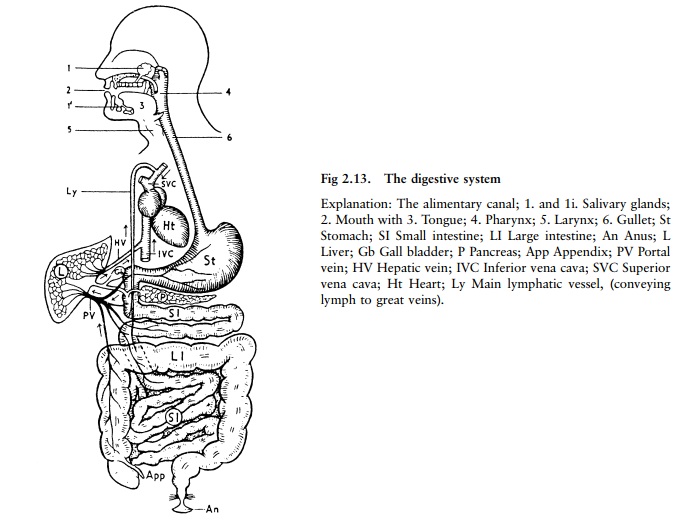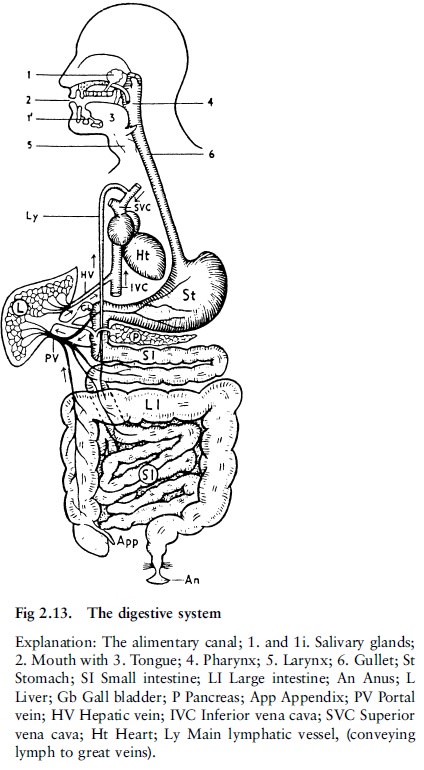Chapter: Forensic Medicine: Basic anatomy and physiology
The digestion stage

The digestion stage (fig 2.13)
Food is prepared for digestion and digested by
the digestive organs in the following manner: food is broken up into smaller
particles by the action of chewing, and becomes warm and moist. The chemical
action of the digestive juices splits these particles into simple substances
which are soluble in water, allowing them to be taken up more easily into the
body. The action of the digestive juices is helped by the mixing and churning
movements of the involuntary muscles of the stomach and intestines (also called
plain or smooth muscles because they are not striped as are the skeletal or
voluntary muscles).
In the mouth the food is broken up by chewing, and moistened by saliva, a digestive juice poured into the mouth from several glands (salivary glands) situated near it.

The act of swallowing passes
the moistened food down the gullet into the stomach. The stomach acts as a
reservoir in which the food is retained until it is thoroughly warmed and
reduced to a fluid condition. The walls of the stomach pour out a second juice
(gastric juice) which also acts upon the food. Upon leaving the stomach the
partially digested food enters the small intestine in a liquid state, and is
there acted upon by the digestive juice of the pancreas (pancreatic juice). The
bile also acts to some extent upon the food. At the same time the walls of the
intestine also secrete a digestive juice (the intestinal juice). The small
intestine is the main area in which digestion takes place.
Thus, in its passage through the digestive
canal, food is continuously undergoing change. Finally, after passing through
the large intestine, the undigested and unabsorbed remainder of the food is
expelled from the body. The passing of the food through the digestive canal
takes about 24 hours.
A normal diet contains, in proportions suited to
the needs of the body, the following three main classes of nutrients:
·
Nitrogenous nutrients found mainly in animal foods (meat, fish, etc),
and which also form the main part of these foods. Several vegetable foods,
however, also contain a considerable amount of nitrogenous nutrients.
·
Starches and sugars, found mainly in vegetables, bread, potatoes, sugar,
fruits, etc. Meats contain virtually no starch or sugar.
·
Fats, found for example in butter, oil, meat, fat and cream.
While all these nutrients serve as sources of
energy, it is chiefly starches, sugars and fats which supply energy. In a
normal diet starches, sugars and fats amount to more than three-quarters of the
total food intake. The main use of nitrogenous nutrients is to repair the
break-down in the living structures of the body.
In addition to these nutrients a normal diet
contains mineral salts and vitamins. These are necessary to the body, but they
are not sources of energy, and the same is true of the water which we drink.
Digestive juices act upon the nutrients in
different ways. Saliva only acts upon starches in the food, and gastric juice
mainly upon the nitrogenous nutrients. Gastric juice is the only acid digestive
juice, and for this reason it has an important action in checking the
development of any infective germs which may have been swallowed.
Partially digested foodstuffs are acted upon in
the small intestine by pancreatic juice, bile, and intestinal juice. All these
are alkaline juices, and together they aid digestion, but the strongest is
pancreatic juice. By the joint action of these juices the digestion of all
three classes of nutrients is continued and completed in the small intestine
where they are reduced to the simple forms in which they can be absorbed into
the body.
In the lower part of the small intestine and in
the large intestine a certain amount of putrefactive change also takes place.
This is due not to the digestive juices, but to the action of germs or
bacteria.
Related Topics